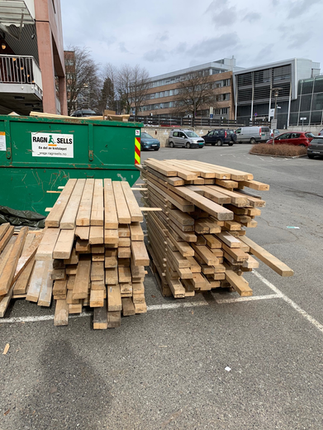Used wood in new CLT?
- Build-in-Wood Team
- Jan 26, 2022
- 3 min read
Updated: Feb 17, 2023
✅️ Used wood can easily be recycled in new mass timber products, such as CLT (cross-laminated timber) and glulam (glue-laminated timber), if it is dry and straight enough.
❌ We need defined quality evaluation processes and common standards throughout the EU to properly get started with reusing wood.

The work on reuse and circular economy in the EU-funded innovation project Build-in-Wood is nearing completion. Advisor Andreas Stenstad at NTI, the Norwegian Institute of Wood Technology, coordinated various experiments on the performance of recycled-wood-planks and -slats and their suitability as raw material for mass timber products.
With increasing demand and price instability of timber products, we see a great opportunity in exploring the potential of reused wood.
explains Stenstad. His research group focused on mass timber, given the building materials popularity in the past years (especially in smaller buildings in the care sector and in schools).
Practical experiments: Reused wood in new CLT slabs

The Build-in-Wood project counts on various generous supporters, one of them being the Norwegian waste management company Ragn Sells. In this case, Ragn Sells provided NTI with discarded slats, that were then cleaned and planed. The old slats were glued up into a five-layered-CLT (cross-laminated timber) prototype.
To reuse old wood for new CLT, various properties and performance values of the returned wood need to be tested.
Build-in-Wood partner NTI conducted the following tests with very positive results:
Stiffness and flexural strength: No weakness detected in the tests
Adhesive tests: The adhesiveness is not weakened
Demolition damage: hardly affects the properties of the returned wood (most of the wood has been through demolition processes)
Shear properties: satisfactory results (tested in prototypes with short spans)
💡 Want to learn more about the topic of reused wood? Download this scientific poster presentation in PDF format, made by NTI 👇
How does used wood perform compared to new wood?
The tests showed that old, recycled wood performs just as well as new wood - as long as it is dry and planed. Stenstad explains that there were no signs of weakness. He even adds that there was “no sign that the wood had been used before”.
We need clear standards for reusing timber

Stenstad believes that we can use returned wood as long as it is dry, straight enough and without foreign elements. Much of the reused wood contains nails, screws and hinges. Those metal parts need to be removed in a simple manner.
As of today, we do not (yet) utilize reused wood in mass timber products. While there is no harmonized standard against the reuse of wood, we also lack a set of regulations on how to use it. NTI stresses that a regulation set for approving returned wood in an effective way (e.g. simplified strength assessment mechanism instead of a full certification process) will be crucial to its acceptance throughout the industry.
Without a proper set of regulations, no one will readily accept the use of returned wood
fears Stenstad.
Download the scientific poster
You want to learn more about the topic of reused wood? Then check out this scientific poster presentation in PDF format, made by NTI 👇
circWood: New big-scale innovation project

To continue the work executed for Build-in-Wood and dig deeper into the recycling options for wood components, NTI joined a consecutive project: circWood. It is funded by the Norwegian government and will align as many as 52 partners (research institutes, universities, timber construction companies, producers etc.). The project will start in January 2022 and will last for three years.
How will the use of recycled wood affect forestry and incineration?
How will the market react to the use of recycled wood?
How can we design buildings to facilitate disassembly for reuse?
👉 Stay tuned, we’ll share more details about circWood once it officially launches!






